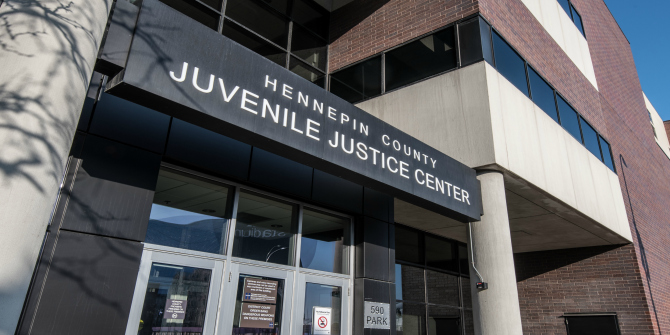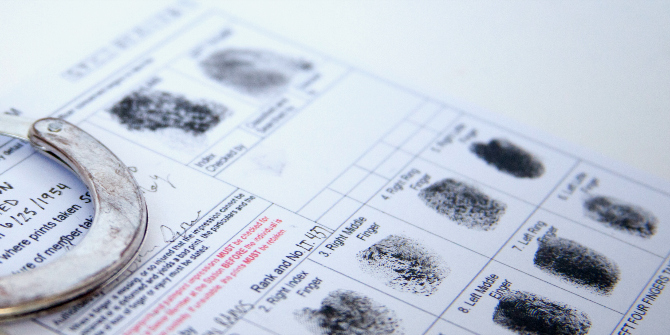In The Pedagogy of Pathologization: Dis/abled Girls of Color in the School-Prison Nexus, Subini Ancy Annamma explores the processes and social factors that place the bodies of multiply-marginalised dis/abled girls of colour in the US criminal justice system, putting their voices at the centre of the book. This is a valuable intersectional view of the prison-school nexus that depicts how justice is experienced and what justice should be through the eyes of those living the journey, recommends Alison Stein.
The Pedagogy of Pathologization: Dis/abled Girls of Color in the School-Prison Nexus. Subini Ancy Annamma. Routledge. 2018.
Subini Ancy Annamma’s The Pedagogy of Pathologization: Dis/abled Girls of Color in the School-Prison Nexus portrays the processes and social factors that place the bodies of multiply-marginalised dis/abled women of colour in the criminal justice system, while also putting the voices and experiences of these individuals at the centre of the book. Annamma adopts Beth Ritchie’s (2012) notion of a ‘prison nation’ and situates schools within this in order to understand how a ‘societal goal’ for public education is to fill prisons (6).
Throughout, Annamma chooses the term ‘dis/abled’ to signify ability as based on social context, continually shifting over time, rather than as a fixed state. In reference to her subjects, Annamma uses the word ‘girls’, though they are well into their teenage, secondary school years. In her discussions, Annamma demonstrates a commitment to intersectionality and DisCrit, which calls for a critical lens that recognises the ways that race and dis/ability are socially constructed interdependently with material, social and political impacts. Annamma employs this lens in order to understand the process behind the creation of the criminal identity in the juvenile incarceration centre and to create a pedagogy of resistance.
Annamma utilises a hybrid of interviews, ‘educational journey mapping’ and observation data to explore the experiences of young, dis/abled girls of colour in juvenile detention centres while also drawing on similar works concerned with intersectionality, DisCrit and the school-prison nexus. The book is organised thematically and, to a certain extent, in order of an educational journey, from the destruction-creation process of schooling to the (re)construction of ‘criminal literacy’ within juvenile incarceration to ‘unprepared exits’ and methods of resistance. While the revelations within each of the chapters are compelling, especially significant is the extent to which The Pedagogy of Pathologization revolves around the voices of ten young women. In this way, Annamma’s analysis, conclusions and implications are positioned as supporting roles to the girls of colour achieving a new vision of justice, formed organically through listening to what they have to say.
 Image Credit: Hennepin County Juvenile Justice Center, Minneapolis, Minnesota (Tony Webster CC BY 2.0)
Image Credit: Hennepin County Juvenile Justice Center, Minneapolis, Minnesota (Tony Webster CC BY 2.0)
Annamma’s research exemplifies a pedagogy of resistance that seeks to build ‘space for the multitude of Strategies of Resistance to the historical and present-day inequities that multiply-marginalized dis/abled girls of color face’ (146). One exercise she conducted was ‘education journey mapping’, through which the young women map their journey from the beginning of their schooling to the present: ‘maps offered a way to trace their journeys through inequities, to consider how they found themselves incarcerated’ (178). Whether through colour, arrows, words or drawings, they were instructed to create a visual map of their time in school: ‘Draw your relationship with school. You can include what works for you and/or what doesn’t’ (179).
After creating these maps, each member of the group had the opportunity to share their map and explain their choices. In some sessions, Annamma led a ‘cartographer’s Clinic’, including the girls in her data collection and analysis by asking them to look at each other’s maps and identify themes between them. Annamma also would call upon these drawings in follow-up interviews. These methods speak to Annamma’s own concurrent calls for DisCrit Curriculum and an intersectional view of juvenile justice for multiply-marginalised dis/abled girls of colour by placing their experiences at the centre and drawing upon the interdependence of the social contexts that marginalise them. While Annamma uncovers the systemic processes that place these young women in prison, the subjects also have the opportunity to build solidarity, have their voices heard and analyse the circumstances surrounding their own trajectories in order to resist them.
Annamma’s work outlines the systematic processes that fill prisons with bodies that are found, destroyed and then (re)constructed as criminals through the ‘pedagogy of pathologization’: namely, hyper-surveillance, hyper-labelling and hyper-punishment (13). Reading the young women’s stories, it becomes clear that ‘institutional absence’, such as lack of access to healthcare, security or childcare in their families, was ignored by adults within the school system; instead behaviours such as truancy or tardiness were treated as conscious decisions that reflected a lack of care. This prepared these young women for criminal literacy, as adults and teachers within the juvenile incarceration facility would isolate the behaviour of the young women from any societal factors and frame their behavior as ‘their choice’. One teacher, Ms Roberts, framed drug use and running away in this way: ‘The judge tried and tried […] finally she went to placement, ran away, went to placement, ran away, got to go home, ran away, paroled, ran away [….] The kids make their decisions and, they (the courts) have no choice […] Cuz the kids keep running away and doing drugs and the courts are right’ (64).
In analysing this quotation, Annamma points to Ms Roberts’s position as not only one of conscious decisionmaking, but also her belief that the only way the girls could learn their lesson was to be incarcerated. In the prison nation, schools and facilities of juvenile incarceration seek to teach personal responsibility through isolating those who are different with no regard for systems of inequality. This is how hyper-surveillance, hyper-labelling and hyper-punishment are practised and validated on dis/abled girls of colour.
Another alarming revelation within Annamma’s findings is the role gender plays in the criminalisation of these multiply-marginalised girls. Mothering was a theme that many of the young women pointed to as a contributing factor to the pedagogy of pathologisation. In Erykah’s case, as a teen mother she was removed from her public school and attended what she described as ‘an alternative school for pregnant girls and people that were bad’ (51). Compounded by her label of dis/ability, her pregnancy put her on the path toward criminalisation. Within juvenile incarceration spaces, staff at the facilities consider themselves to be responsive to the specific gendered needs of girls, with special regard to how differently the girls should be treated compared to teenagers who are not incarcerated. One teacher, Ms Cradler, validated relationship policies based on what she believed was responsive to the specific needs of incarcerated juveniles: ‘when kids are doing their thing together […] we don’t call it a relationship, we call it an intimacy issue because truly they can’t have the same relationship in here that they can as a regular high school student in a public setting […] I mean what we find is that it’s just extremely sexually charged’ (84).
The pervasive sense that young women must be surveilled based on the unscientific assertion that they are inappropriately intimate by nature, and thus the need to criminalise sexuality, pregnancy or motherhood, especially when bodies of colour are involved, can be found in schools and in juvenile incarceration.
In her chapter on ‘Release and Resistance’, Annamma hones in on the school-prison nexus to understand incarceration and reincarceration, largely due to the systemically marginalising, criminalising factors that are typically ignored by the overarching goal of fostering obedience, accountability and personal responsibility. The pedagogy of pathologisation leaves these young women unprepared to exit juvenile incarceration. Annamma gives voice to a young woman who was unable to apply for college due to the constraints of privileges while incarcerated (111), a young mother who was never allowed to make her own doctor’s appointments for herself or her child (114) and a young woman who had internalised warnings about associating with friends who were ‘like family’ before she was incarcerated (116).
Ultimately, through a mentality of ‘improvement through abandonment’, these young women are ejected from juvenile incarceration haphazardly, with no regard for the institutional failures that led them to be incarcerated. Through this notion, 30% of girls return to detention within a year, 53% for probation violations as opposed to 41% of boys returning to prison for the same reason (117). The girls are aware of the odds stacked against them, as one young woman, Ashley, offered that she would join the military because she ‘needs discipline’ (118). Annamma analyses this, and sums up what happens upon an unprepared exit from incarceration: ‘it could be inferred that she did not trust herself, but she knew that without a concrete release plan, she could end up incarcerated again’ (118). Ashley could not ensure her own safety re-entering the circumstances, the absence of institutions and lack of societal care that put her in juvenile detention in the first place.
A final theme revealed in Ashley’s exit plan to join the military has an important implication for Annamma’s work: resistance. Annamma analyses the ways that her subjects managed to employ strategies of resistance in order to get through their time while incarcerated. Annamma evokes Faranak Miraftab and Shana Willis (2005) and their notion of ‘invented spaces’ that marginalised citizens create to respond to their needs (125). Within the lack of freedom or mobility in juvenile incarceration, the girls individually created ways to get by or comply while claiming their own independence to ‘strategically get access to freedom’ (126). Annamma’s description of the work of strategies of resistance as necessary in and outside of incarceration is both haunting and hopeful, as these young women will likely feel the need to create invented spaces upon their exit in order to find freedom while managing their multiply-marginalised status. In this way, employing strategies of resistance is a reclaiming of citizenship that serves to interrupt the destruction and creation processes bound up in the pedagogy of pathologisation.
Ultimately, to expand justice, Annamma calls for a pedagogy of resistance, based on DisCrit curriculum, pedagogy and solidarity (146). Remarkably, even in painting a picture of this, she draws from the young women themselves. In describing DisCrit Solidarity, Annamma quotes a young woman from her study:
Imani imagined solidarity that was evident in the ways teachers treated students. ‘‘[…]They wouldn’t think just because you’re not my kid, I’m gonna yell at you. You know? They treated me like I was theirs. So like they’ll have a sit down and talk to me” (154).
Herein lies Annamma’s success in depicting how justice is experienced and what justice should be, critically and substantially through the eyes of those who are living the journey. This work in its findings and methods will serve as a model for future researchers who seek an intersectional view of the school-prison nexus that puts the voices of those being criminalised and pathologised at the front and centre.
Note: This review gives the views of the author, and not the position of the LSE Review of Books blog, or of the London School of Economics.
Image Credit: Hennepin County Juvenile Justice Center, Minneapolis, Minnesota (Tony Webster CC BY 2.0).


 Find this book:
Find this book: 





1 Comments